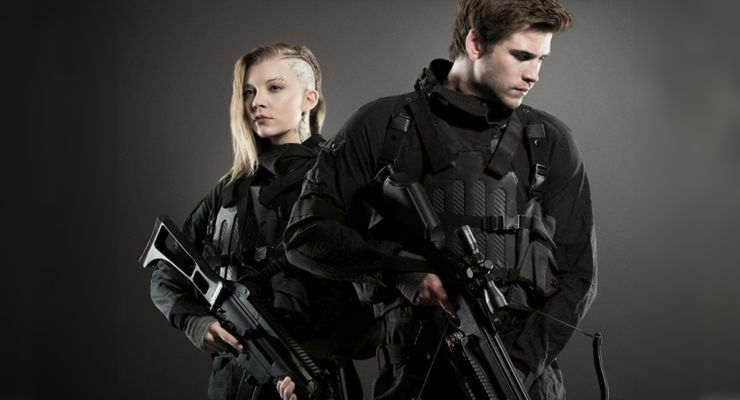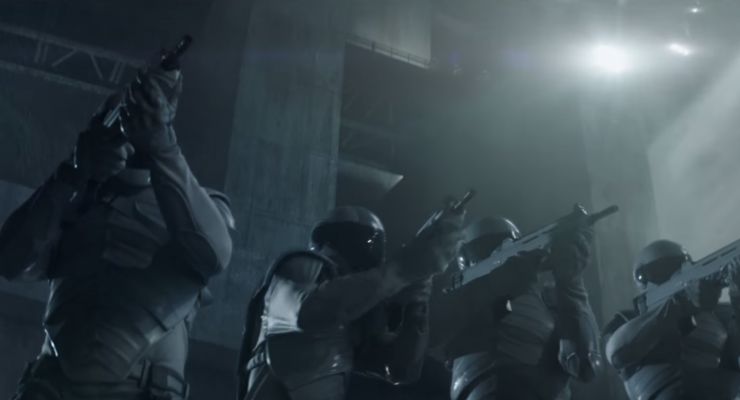 by Soo Youn – The Hollywood Reporter ~ “The Hunger Games guns rebellion was almost squashed,” says Hollywood Reporter, “not by the Capitol’s forces, but by international gun laws.”
by Soo Youn – The Hollywood Reporter ~ “The Hunger Games guns rebellion was almost squashed,” says Hollywood Reporter, “not by the Capitol’s forces, but by international gun laws.”
In Mockingjay — Part 1, Jennifer Lawrence’s Katniss Everdeen sports a fiery bow and arrow, but everyone else in the dystopian Panem needs to rely on conventional weapons. For the film’s production team, that meant a couple dozen real-world FN F2000 assault rifles and FN P90 machine guns — futuristic-looking firearms often used by the military. But it also presented a problem: how to get the weapons shipped to Europe for back-to-back shoots in different countries, all on a tight schedule. Like all firearms used in movies, prop assault rifles and machine guns are modified to shoot blanks, but are still regulated as guns by local, state, federal and international governments.
The entire process starts in the U.S., which is notoriously more lax about guns than most countries. “Any film going overseas, we’re sending our armorers; they’re in control the whole time, according to U.S. law,” says Karl Weschta, general manager of the armory at Independent Studio Services, the Southern California prop house that supplied the guns. “Now, Germany has different laws, and they want their people in control or their police force in control the whole time. So we have multiple responsible parties when guns are overseas. And everybody is in charge, essentially. And of course … our State Department wants to know who the foreign person is that’s going to be responsible, as well.”
Due to the U.S. legal restrictions, the guns couldn’t be sent off to Europe and then hop from country to country, causing complications for the multi-national shoot. “We can’t take the firearms and ship them out to France, and then go from France to Germany with them,” says Weschta. “We could do it, but they would have to come back here [to the U.S.] first and then go back out anyway.”
Ultimately, two discrete batches were sent — one to France, and one to Germany. “Luckily, the kind of firearms they were using, we were able to make it work for both,” he says. “I think there were some supplemental guns that came out of an armory in the U.K., and also in Germany.” (Read Entire Article)

The Hunger Games Guns – Hollywood’s Science Fiction Futuristic-looking Guns
By Jeremy Hsu – Discover Magazine ~ You’ve probably seen a bullpup gun even if you don’t know what it is. Millions of moviegoers have seen The Hunger Games guns, futuristic-looking guns that appear in the hands of Peacekeepers, the militarized law enforcers of the dystopian Capitol government in the Hunger Games films. The unusual shapes of bullpup guns have also featured in many past science fiction films such as the “Terminator” films, Total Recall, Stargate and the Robocop series. But military, law enforcement and civilian gun users remain divided over whether the bullpup design represents an improvement over conventional gun designs.
The mystique of bullpup guns arises from how they overturn the past 500 years of firearm design. Traditionally, most gun designs have placed the trigger behind the gun’s magazine and action. The magazine stores cartridges — units of ammunition that include the bullet, powder and primer — while the gun’s action mechanism loads, fires and ejects cartridges. A conventional design that placed the gun’s action farther away from the user’s face made sense early on in the history of guns, especially when imperfect gun designs or materials risked the weapons exploding. By comparison, bullpup guns place the trigger in front of the magazine and action. That means the magazine and action can fill the space normally taken up by the gun stock, which allows for a shorter weapon overall. Yet the advantages and disadvantages of bullpup gun designs remain a topic of controversy among gun users.
“This argument between bullpups and standard guns has been around for 60 years,” says Richard Stone, an associate professor of industrial and manufacturing systems engineering at Iowa State University.
Bullpup designs first appeared at the beginning of the 20th century, but only really took off in the 1970s and 1980s with the first modern bullpup assault rifles such as the Austrian-made Steyr AUG. Despite some initial problems, the shorter design of bullpup guns makes them easier to use in close-quarters urban combat or while firing from inside cramped vehicles — battle conditions that have become increasingly relevant in the modern world. Bullpup guns have become standard use among the militaries of certain European countries, Israel, China and Australia, among others, but the U.S. military and U.S. civilian market have largely avoided bullpup guns. Fierce debates have raged in online forums devoted to guns about whether the bullpup or standard gun designs have the edge in various shooting scenarios.
Stone first encountered this debate while working with a group of former and current U.S. military and law enforcement personnel. The gun experts had begun arguing the finer points of what made for the best assault rifle. Most of them favored the conventional wisdom that viewed bullpup guns as being less accurate and potentially being slower to reload. But Stone wasn’t so sure. He doesn’t consider himself a “gun guy,” but from a physics and ergonomics standpoint, he thought that the bullpup guns should have the edge in accuracy and stability. So he and his fellow researchers enlisted a group of 48 people to compare bullpup and conventional guns in live-fire exercises at the local sheriff’s gun range in rural Iowa.
Duel of the Guns
The study had two showdowns between conventional and bullpup guns. First, the conventional Smith & Wesson M&P15T (a variant of the M4 rifle) was pitted against a FN Herstal FS2000 (which coincidentally appears in “The Hunger Games” films). Second, a conventional Ruger 10/22 rifle went up agains the bullpup configuration of the Ruger 10/22 rifle. Participants tested each of the guns in a “Vice President” combat drill that required them to fire 12 shots into three targets at a distance of 25 yards. Such a distance is roughly similar to the standard scenario for law enforcement officers engaged in firefights with “active shooter” suspects.
Researchers did more than just look at the final accuracy of the participants. They also measured the stability of the gun users by having them stand on a “force plate.” They also attached accelerometers to the ends of the guns in order to track the sway of the gun barrels — a jerking movement accompanying each gunshot that means gun users must bring their gun barrel back on target for the next shot. Acoustic sensors captured the exact moment of each cartridge’s propellant charge going off and firing each bullet.
In the end, the bullpup guns showed a small but significant boost in accuracy compared to the conventional guns. Similarly, the biomechanical tracking of user stability found that the bullpup guns offered better stability for their users. Reload times and overall time to complete the drills were not significantly different from a statistical standpoint. (Additional details can be found in the paper published in the journal Human Factors.)
Such results favoring the bullpup guns in this particular case went against the expectations of the study’s participants. All of the participants had at least some prior firearms training from military or law enforcement, but some also represented more expert gun users as former or current members of the U.S. military or law enforcement agencies. (“The Marines were the best shots, amazing shots,” Stone says.) A post-study questionnaire showed that a majority of those participants favored the conventional guns in terms of comfort level — not surprising given how few U.S. military and civilian gun users have used bullpup guns. In fact, most believed they had performed better with the conventional guns before they saw the results.
If anything, the U.S. comfort level and familiarity with conventional guns should have biased the results in favor of the conventional gun performance. Stone’s study results may encourage some Americans to reexamine their cultural preferences and take a second look at bullpup guns. “Most of the people were surprised they could shoot better with the bullpup guns,” Stone explains.





